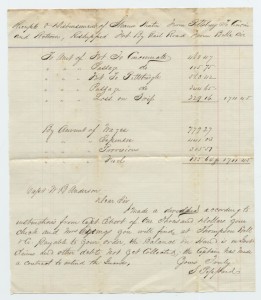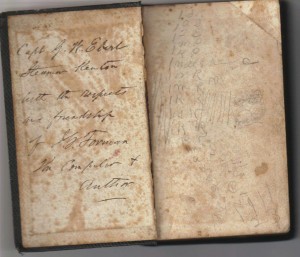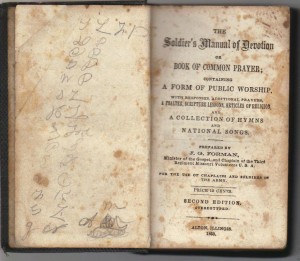Str Kenton
The Kenton was a sternwheel wooden hull packet built in Shousetown, PA and completed at Pittsburgh in 1860. Its capacity was rated at 215 tons. The boat was built under the direction of Capt Nelson Crooks who was also one of its first owners. In Oct 1861 Capt George W Ebert and Standish Peppard, both from Georgetown, PA, bought an interest in the steamer for the Pittsburgh to Cincinnati to Louisville trade. [1] A short time after the purchase, the Kenton was called to service by the US Army Quartermaster.
Whether the Kenton was initially under temporary impressment or charter by the Union Army Quartermasters is unclear. Whether impressed or contracted, the subject of military transport by civilian crews generated legal problems in the fields of discipline, pay, handling of prisoners, and eligibility for pensions. There was discernable friction between the military and civilian regulatory agencies. In 1862 Col Lewis B Parsons, in charge of military transportation on western rivers, issued an order that “if anywhere on the Mississippi…if a pilot demanded wages exceeding $200 a month, he was to immediately have his license revoked.” [2] Obviously Col Parsons was struggling with the high spirited rivermen over issues of salary and operational control of their packets. At that time, the issuance and revocation of pilot’s licenses was controlled by the Steamboat-Inspection Service established by the steamboat act of Aug 30, 1852. Pilots were the princes of the river. Without pilots, a packet was worthless. Not all captains were qualified pilots, and not all pilots aspired to be captains. Even when serving a captain who was a qualified pilot, the pilot at the wheel reigned supreme during his allotted watch. This civilian order of control was in conflict with the military chain of command. Both the pilot’s guild and the Steamboat–Inspection Service lost power. Under Army control, the civilians –captains, pilots, clerks, stewards, engineers, mates, deckhands – were subject to military discipline and, if captured, were subject to the same treatment extended to members of the army and navy. Under the Military Pension Act of 1862, the only civilians recognized were those who served on gunboats and other war vessels owned by the Army Quarterrmaster.[3] All in all, a civilian steamer and its crew, especially if impressed to service, was not a good business proposition.
The Kenton and its crew were chartered for service by the Quartermaster from 27 Dec 1861 to 5 Jan 1862 and from 6 Jan for an unknown duration of time[4]. The Clara Poe commanded by Capt Thomas W Poe was transporting troops and supplies in 1862 so I assume the Kenton was also busy with government work. Kenton receipts for three round trips between Pittsburgh and Louisville and Pittsburgh and Cincinnati were in the papers of Capt William B Anderson (civilian riverboat captain and pilot). Trip number 13 was dated 24 Apr 1862; trip number 10 was undated but signed by Standish Peppard (owner and first clerk of the Kenton), and the third receipt was neither dated nor signed. Capt Anderson was quite probably one of the pilots of the Kenton on these trips. In the Ohio State University Rare Books Collection, his letters to his wife were dated after 24 Apr 1862. He wrote of the Kenton in the past tense which suggests he had moved to another packet. In the letters, he also expressed his concern about being drafted while between government contracts and paying a $1,000 fine about avoiding the draft. He also wrote about two captains, Capt Adams and the captain of the Florence Miller, arrested for cowardice by General Wright. The Florence Miller was a tinclad packet. The conflict between military and commercial control of the vessels was real.
The Kenton on 6 Jan 1862 was chartered to “receive on board… a detachment of US troops consisting of 11 officers and 267 enlisted men… thirty horses and 15 wagons”. The transport charter was from Gallipolis to Louisville at a rate of one-thousand dollars for the trip. The charter ws signed by GW Ebert and witnessed by Standish Peppard.
From 23 Dec to 31 Jan 1863, Capt Ebert and the Kenton were on the central Mississippi. [5] On Jan 1, 1863, Gen WA Gorman writing to Gen Hurlbut in Memphis states that Capt White informed him that our fleet was “in great need of coal. I send the steamer Kenton to report to you. See if it is possible to send two barges of coal to Gen Sherman and the fleet.” The Kenton was ordered to Memphis to acquire two barges of coal and return to the Helena or Napoleon, AR. Other steamboats with barges of coal, the Blue Wing and Home, had been captured by the rebels. “The fighting Monday was terrific, our loss perhaps 2,000 or 3,000.” [6]
On Jan 12, 1863, the Kenton was moored near the mouth on the White River according to a personal letter by Lt Cushman K Davis of the 28th Wisconsin Regiment. Lt Davis was the aide-de-camp to Gen Willis Arnold Gorman. Approximately 18,000 troops had been transported to the White River from Helena or Napoleon, AR by a fleet of 30 steamers. The Kenton steamed five difficult miles up the swollen White River on Jan 13. According to Lt Davis, the old General spent most of his time in swearing at the pilot who may have been Capt George W Ebert. On Jan 15 the 28th Wisconsin was visited by a terrific snowstorm. After finding no fight on the White River, the 28th Wisconsin was ordered to Vicksburg for the purpose of another attack. [7]
Imagine the sight. Thirty packets steaming down the Mississppi. The average packet was 185 ft x 33 feet not including its wheel. Its stacks were 50-75 feet high. With the usual 100 yards between boats that would calculate to nearly four miles of steamboats, bow to wheel, belching black smoke and raining sparks from their stacks.
The Kenton was chartered from 1-31 Mar 1863. [8] During this period in 1863, a prayer book was given to Capt Ebert by one of his passengers. The book, “The Soldier’s Manual of Devotion”, authored by Rev Jacob G Forman, the Chaplain of the Third Regiment Missouri Volunteers USA was inscribed as follows:
Capt G. W. Ebert
Steamer Kenton
with the respect
and friendship
of J. G. Forman
the compiler &
author
According to the Official Army Registry of the Volunteer Forces of the US Army, Rev JG Forman resigned on May 25, 1863.[9] As chaplain of the Third Regiment of the Missouri Volunteer Infantry (3 year enlistment), he was assigned to the District E Arkansas and participated in the Sherman Yazoo Expedition. [10] Quite possible Rev Forman was aboard the Kenton in Jan 1863 and befriended Capt Ebert, a Bible reading Methodist from Georgetown, PA.
During the war years, Rev JG Forman worked in hospitals and camps where freed slaves, including women and children, were encouraged to go. Rev Forman also made appeals for aid for the “destitute contrabands” in Helena, AR according to an article in the NY Times published Nov 8, 1862. Well known in anti-slavery circles, Louisa May Alcott wrote about his work in “On Race, Sex, and Slavery”. Rev Forman authored works on the contribution of women to the war effort.
In Oct 1863, Capt Ebert and Standish Peppard sold the Kenton to Capt JH Dunlap of Bridgewater, PA. For the duration of the Civil War the streamer was in US service. The Kenton was chartered from 6 Nov 1863 to 18 Mar 1864. On 18 Jan 1864, the “Veteran Seventh” PA Dragoons took passage on the steamer Kenton. We sailed down the Cumberland; passed Clarksville, Fort Donelson, Paducah, places memorable in history; sailed down the Ohio to Cairo, where we arrived on the nineteenth of January. At the same time a steamer arrived from Vicksburg, having on board the Forty-sixth Illinois Infantry, in command of Colonel Benjamin Dornblaser, also going home on veteran furlough. The colonel spent several hours very pleasantly on the Kenton, in company with his nephew and several of his former neighbors in the old “Keystone State.” The “Seventh” lay at Cairo two days waiting for transportation. [11]
The Kenton was employed from 26 May to 31 Aug 1864. I have not learned the difference between the term chartered and employed. [12]
The last charter for the Kenton was 1 Sep to 25 Oct 1864. [13] During that period of time, a grisly encounter occurred. While moored at Eastport on the Tennessee River on Oct 10, 1864, a rebel force attacked from both shores. The Kenton was struck 50 times with shells. Many exploded onboard. One shell exploded in the engine room rupturing a steam line, killing a watchman, and causing general havoc. Capt Dunlap got her away from the landing while the crew extinguished the fire. Those who saw the boat after the attack reported the Kenton was riddled with shot. The zeal displayed by his crew according to Capt Dunlap was prompted by visions of spending the rest of the war in Libby Prison. [14] Earlier during the month, the Kenton had also been fired into below Clarendon on the White River according to the NY Times archive report dated 4 Oct 1864.[15]
In Sep 1868, Capt Dunlap sold the Kenton to Capt Wash Kerr for the Pittsburgh to Portsmouth trade. Then in 1869, Capt Kerr sold the boat to Capt Henry U Hart for the Cincinnati to New Orleans trade. On May 5, 1870, the Kenton was snagged and lost opposite Helena, AK. [16]
Summary.
The steamer Kenton had a long life and well documented historic life. Some of the infomation collected during the Civil War years came from the document held at the National Archives. To hold documents signed by George W Ebert and Standish Peppard is amazing and intimidating simultaneously. I continue to search for photographs of both Georgetown men.
The soldier devotional book was one of a few personal effects of George W Ebert still possessed by my family. The Ebert home in Georgetown is owned by my sister and her husband, but its contents were removed/replaced through the years. We continue to look for original articles that belonged to the Eberts.
References.
[1] Frederick Way, Jr.,Way’s Packet Directory, 1848-1994, (Ohio University Press, Athens 1994), p. 269
[2] Charles Dana Gibson, MilitaryTtransport, Civilian Crews, During the Civil War,(Periodical Vol XVI, No 1,Apr 1989), pg 3-20.
[3] I Charles Dana Gibson, MilitaryTtransport, Civilian Crews, During the Civil War,(Periodical Vol XVI, No 1,Apr 1989), pg 3-20.
[4] Charles Dana Gibson and E Kay Gibson, Dictionary of Transports and Combatant Vessels Steam and Sail Employed by the Uniion Army 1861 – 1868, (Ensign Press, Cambridge, MA 1995), p 189.
[5] Charles Dana Gibson and E Kay Gibson, Dictionary of Transports and Combatant Vessels Steam and Sail Employed by the Uniion Army 1861 – 1868, (Ensign Press, Cambridge, MA 1995), p 189.
[6] Maj George B Davis, Mr Leslie J Perry, and Joseph W Kirkley, The War of the Rebellion: A Compilation of the Official Records of the Union and Confederate Armies, (Vol XVII Aug 1, 1891), Pg 522.
[7] Lt Cushman K Davis Ltr, The Waukeska Freeman Newspaper, Feb 3, 1863.
[8] Charles Dana Gibson and E Kay Gibson, Dictionary of Transports and Combatant Vessels Steam and Sail Employed by the Uniion Army 1861 – 1868, (Ensign Press, Cambridge, MA 1995), p 189.
[9] Official Registry of the Volunteer Forces of the US Army, (Vol VII), pg 82.
[10] Frederick H Dyer, A Compendium of the War of Rebellion, (Vol II), Pg 1323.
[11] T. F. DORNBLASER, SABRE STROKES of the PENNSYLVANIA DRAGOONS in the WAR OF 1861-1865.
INTERSPERSED WITH PERSONAL REMINISCENCES, , p140.
[12] Charles Dana Gibson and E Kay Gibson, Dictionary of Transports and Combatant Vessels Steam and Sail Employed by the Uniion Army 1861 – 1868, (Ensign Press, Cambridge, MA 1995), p 189.
[13] Charles Dana Gibson and E Kay Gibson, Dictionary of Transports and Combatant Vessels Steam and Sail Employed by the Uniion Army 1861 – 1868, (Ensign Press, Cambridge, MA 1995), p 189.
[14] Frederick Way, Jr.,Way’s Packet Directory, 1848-1994, (Ohio University Press, Athens 1994), p. 269.
[15] The New York Times (4 Oct 1864).
[16] Frederick Way, Jr.,Way’s Packet Directory, 1848-1994, (Ohio University Press, Athens 1994), p. 269.
Copyright © Francis W Nash
All Rights Reserved


